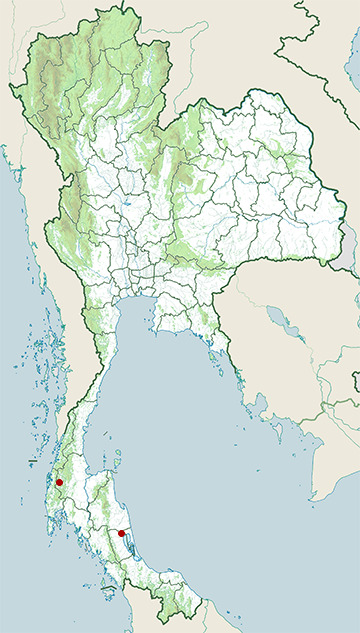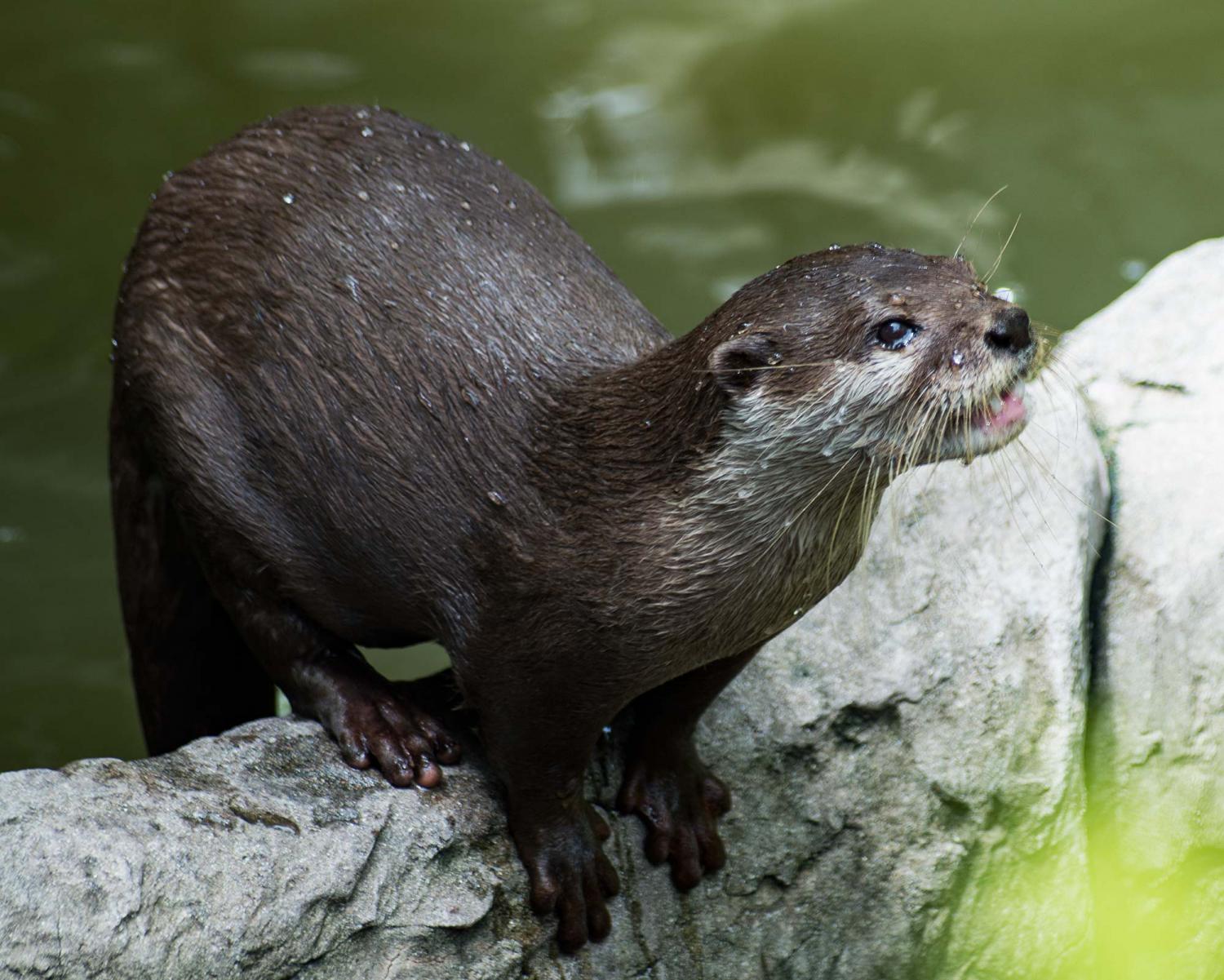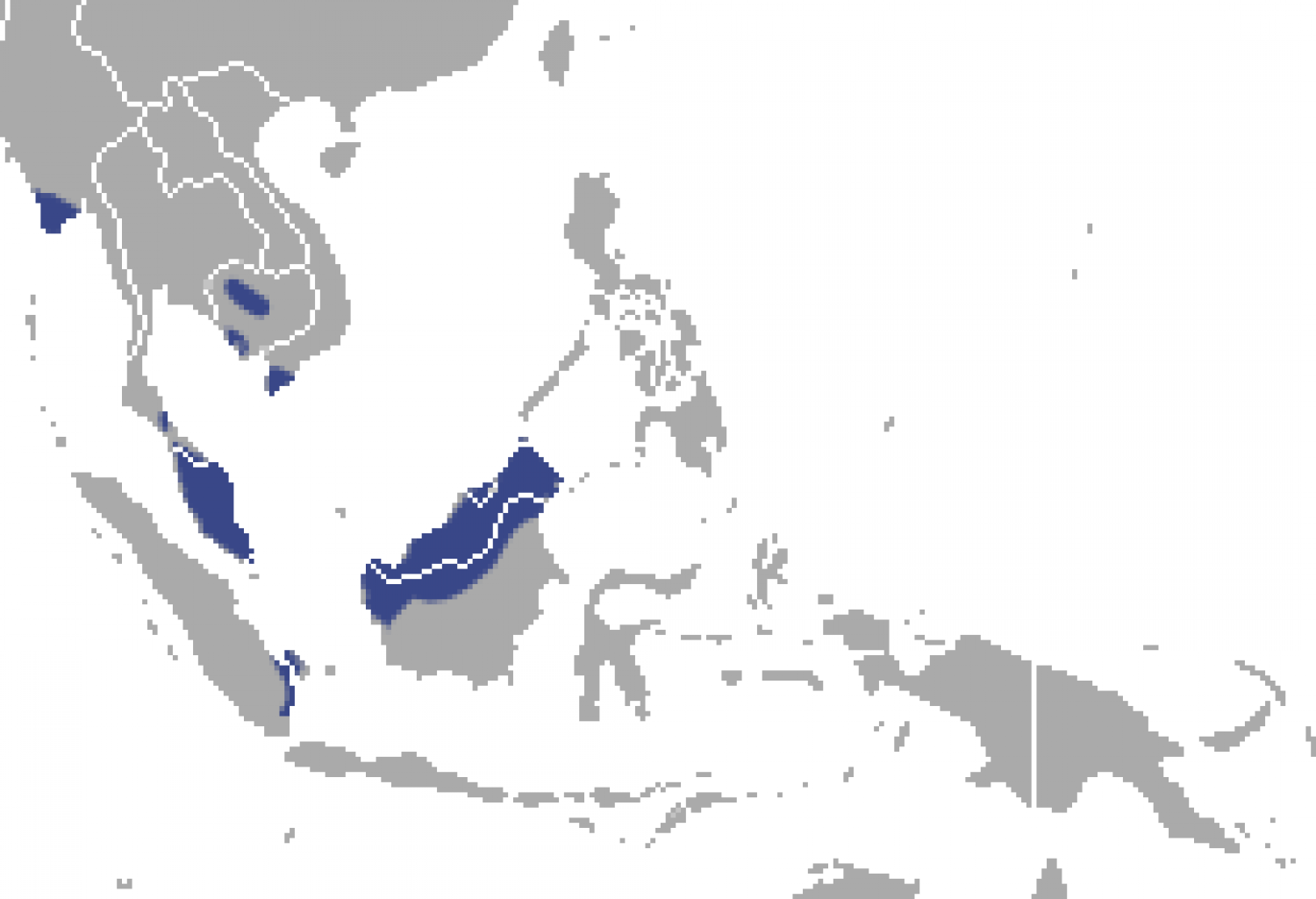Species of Thailand
Hairy-nosed otter
Lutra sumatrana
(John Edward Gray, 1865)
The hairy-nosed otter (Lutra sumatrana) is a semiaquatic mammal endemic to Southeast Asia and one of the rarest and least known otter species. It is threatened by loss of natural resources and poaching.
Description
The hairy-nosed otter has a short brown fur that becomes paler on the belly. Its rhinarium is covered with short hair. Its upper lip and chin are whitish. Some individuals are reddish-chestnut in colour. Its body is long, its tail slender, and its fully webbed paws have prominent claws. Head-to-body length ranges from 57.5 to 82.6 cm, tail length from 35 to 50.9 cm, and weight from 5 to 8 kg.
Its skull is flatter than that of smooth-coated otter, and it has smaller teeth. Its forepaws are 5.8 cm wide and smaller than the hind paws with about 6.6 cm.
The hairy-nosed otter is the least known of the Asian otters, and is also the most difficult to identify in the field. In most other respects, it is similar to the European otter (Lutra lutra).
Distribution and habitat
This hairy-nosed otter occurs in Southeast Asia from southern Thailand, Cambodia, southern Vietnam and Peninsular Malaysia to Sumatra and Borneo. The species is under constant threat of poaching and possibly extinct in India, Myanmar, and Brunei.
In Thailand, it was recorded in the Pru Toa Daeng peat swamp forest and in areas around the Bang Nara river. It mainly habits lowland flooded forests with climaxing vegetation in three levels: a primary forest zone, a secondary forest zone made up of Melaleuca cajuputi, and a third zone of grasslands. These tiers make the habitat hard to penetrate, providing protection from human disturbance and cover from predators. The Bang Nara river habitat, where communities have been discovered, is tidal. The two reserves in Vietnam are both peat swamp forests, surrounded by 15m high Melaleuca cajuputi, covered in dense lianas such as Stenochlaena palustris in its primary zone, and a second zone of meadows made up of Eleocharis dulcis. These two Vietnamese reserves contain many canals and floating aquatic plants like Eichhornia crassipes, Pistia stratiotes, Salvinia cucullata and Ipomoea aquatica to hunt and play in, with surrounding rice paddies as a third buffer zone.
In Cambodia, it was recorded in lowland flooded forest around Tonle Sap Lake. Even from these places, they are known from a tiny number of sightings and some roadkill, and from skins.
In Vietnam, it was sighted and recorded by camera traps in U Minh Thuong National Park in 2000, where also spraints were found with fish scales and remains of crabs. In 2008, it was also recorded in U Minh Ha National Park.
In Sumatra, a hairy-nosed otter was killed on the road next to the Musi River in 2005.
In Sabah, historic records date to the late 19th century. In 2010, one individual was recorded for the first time by a camera trap in Deramakot Forest Reserve incidentally. In 2016, several individuals were sighted in Tabin Wildlife Reserve.
Ecology and Behavior
The hairy-nosed otter occurs in coastal areas and on larger inland rivers, solitary or in groups of up to four. Its diet includes fish, such as walking catfish, snakeheads, and climbing perch, and water snakes, mollusks, and crustaceans.
During the dry season, individuals forage in drainage canals and ponds.
Pairing of a male and a female may be limited to the breeding period. The contact call between otters is a single-syllabic chirp. Adult females call to pups with a staccato chatter.
Not much is known about its breeding habits. Populations in the Mekong Delta possibly breed in November and December, and in Cambodia between November and March. The gestation period lasts around two months. A family of both parents and cubs were sighted between December and February.
Foraging is the main food-acquisition technique due to increased variation in monsoonal patterns in recent years due to global climate change.
Conservation
The hairy-nosed otter is the rarest otter in Asia, most likely verging on extinction in the northern parts of its range and of uncertain status elsewhere. Only a few viable populations remain, widely scattered in region. The species is threatened by loss of lowland wetland habitats, hunting for fur and meat, and accidental killing during fishing.
In captivity
In June 2008, the Wildlife Alliance-led Wildlife Rapid Rescue Team received a donated hairy-nosed otter caught near Tonle Sap. Working with Conservation International, they established a safe home for the rescued otter at the Phnom Tamao Wildlife Rescue Centre, but the otter, which had been frequently sick throughout its life in captivity, died of unknown causes in February 2010. Phnom Tamao Wildlife Rescue Centre rescued another hairy-nosed otter in July 2010, and hope it will become part of a future captive breeding program. This is currently the only known hairy-nosed otter in captivity.
This article uses material from Wikipedia released under the Creative Commons Attribution-Share-Alike Licence 3.0. Eventual photos shown in this page may or may not be from Wikipedia, please see the license details for photos in photo by-lines.
Scientific classification
- Kingdom
- Animalia
- Phylum
- Chordata
- Class
- Mammalia
- Order
- Carnivora
- Family
- Mustelidae
- Genus
- Lutra
- Species
- Lutra sumatrana
Common names
- German: Haarnasenotter
- English: Hairy-nosed otter
- Spanish:
- Nutria de sumatra
- Nutria de Sumatra
- French:
- Loutre de sumatra
- Loutre de Sumatra
- Italian: Lontra dal naso peloso
- Dutch: Sumatraanse otter
- Russian: Суматранская выдра
- Swedish: Sumatrautter
Conservation status

Endangered (IUCN3.1)
Photos
Please help us review our species pages if wrong photos are used or any other details in the page is wrong. We can be reached via our contact us page.
Range Map

- Khao Sok National Park
- Thale Noi Non-Hunting Area


